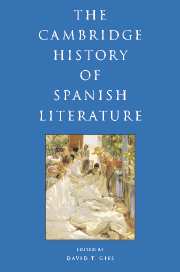Book contents
- Frontmatter
- I INTRODUCTION
- II HISTORY AND CANONICITY
- III THE MEDIEVAL PERIOD
- IV EARLY MODERN SPAIN: RENAISSANCE AND BAROQUE
- V THE ENLIGHTENMENT AND NEOCLASSICISM
- VI THE FORGING OF A NATION: THE NINETEENTH CENTURY
- 22 Romanticism in Spain
- 23 The theatre in Romantic Spain
- 24 Mariano José de Larra
- 25 Romantic poetry
- 26 Romantic prose, journalism, and costumbrismo
- 27 Benito Pérez Galdós
- 28 The Realist novel
- 29 The Naturalist novel
- 30 The theatre in Spain 1850–1900
- 31 Poetry in the second half of the nineteenth century
- VII THE MODERN, MODERNISMO, AND THE TURN OF THE CENTURY
- VIII TWENTIETH-CENTURY SPAIN AND THE CIVIL WAR
- IX IN AND OUT OF FRANCO SPAIN
- X POST-FRANCO SPANISH LITERATURE AND FILM
- Bibliography
- Index
- References
26 - Romantic prose, journalism, and costumbrismo
from VI - THE FORGING OF A NATION: THE NINETEENTH CENTURY
Published online by Cambridge University Press: 28 March 2008
- Frontmatter
- I INTRODUCTION
- II HISTORY AND CANONICITY
- III THE MEDIEVAL PERIOD
- IV EARLY MODERN SPAIN: RENAISSANCE AND BAROQUE
- V THE ENLIGHTENMENT AND NEOCLASSICISM
- VI THE FORGING OF A NATION: THE NINETEENTH CENTURY
- 22 Romanticism in Spain
- 23 The theatre in Romantic Spain
- 24 Mariano José de Larra
- 25 Romantic poetry
- 26 Romantic prose, journalism, and costumbrismo
- 27 Benito Pérez Galdós
- 28 The Realist novel
- 29 The Naturalist novel
- 30 The theatre in Spain 1850–1900
- 31 Poetry in the second half of the nineteenth century
- VII THE MODERN, MODERNISMO, AND THE TURN OF THE CENTURY
- VIII TWENTIETH-CENTURY SPAIN AND THE CIVIL WAR
- IX IN AND OUT OF FRANCO SPAIN
- X POST-FRANCO SPANISH LITERATURE AND FILM
- Bibliography
- Index
- References
Summary
Even the briefest of engagements with modern Spanish history makes clear that the cultural production of much of Spain’s nineteenth century takes place against the backdrop of relentless social, political, and economic upheaval. Indeed, when one contemplates some of the more salient features of that history – a bankrupted monarchy, Napoleonic occupation, the birth of liberalism in the Cortes of Cadiz (1812), the despotic reign of Fernando VII’s repressive Ominous Decade (1823–1833), the collapse of empire in South America, repeated constitutional crises, a series of Carlist civil wars (so-named after Fernando’s brother Carlos, pretender to the Spanish throne), habitual military coup by pronunciamiento, etc. – it is easy to lose sight of the fact that such disparate events are themselves symptomatic of the more fundamental transformation throughout Europe that, beginning with the French Revolution, had begun to supplant the social structures of an aging ancien régime with those of a modern bourgeois order.
The literary prose of the Romantic period in Spain is, in the broadest sense, a register of the cultural turmoil that accompanied this grand transformation. It is the vehicle of public expression for writers whose society was fitfully working its way toward bourgeois hegemony and a liberal political order. Romantic responses to this process of social change were varied, multifaceted, and often contradictory. This was so in part because their very tools – their modes of knowing and the language they used to represent it – were themselves immersed in the tumultuous changes they tried to address. As such, the principal categories into which literary historians have traditionally subdivided Romantic prose – the historical novel, the cuadro de costumbres, and the poetic legend – tend to sit uneasily, even antithetically, beside one another.
- Type
- Chapter
- Information
- The Cambridge History of Spanish Literature , pp. 381 - 391Publisher: Cambridge University PressPrint publication year: 2005

